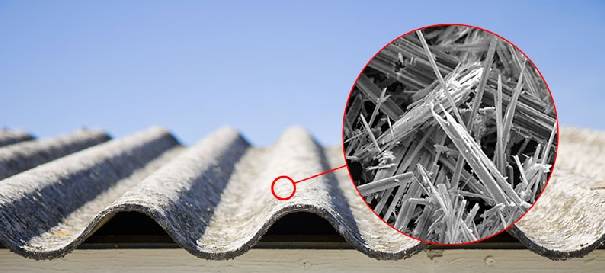What Is Asbestos?
Asbestos is a carcinogenic mineral. It consists of flexible fibers resistant to heat, electricity and corrosion. These qualities make the mineral useful in many products. They also contribute to asbestos exposure toxicity.
Construction materials contained asbestos because it’s an effective insulator. Asbestos in cloth, paper, cement, plastic and other materials makes them stronger.

Asbestos
Asbestos, a mineral known for its carcinogenic properties, comprises flexible fibers that possess resistance to heat, electricity and corrosion. These qualities made asbestos valuable for various product applications. However, these same qualities contribute to the risks associated with asbestos exposure.
Key Facts About Asbestos
- Exposure to asbestos happens in occupational settings and in homes throughout the U.S.
- Asbestos exposure is the primary cause of mesothelioma. This cancer forms in the lining of the lungs or abdomen.
- Other types of cancer caused by asbestos include lung, ovarian and laryngeal cancer. Exposure may cause scarring of the lungs or asbestosis.
- U.S. companies produced thousands of products containing asbestos until the 1980s
What Are Asbestos-Containing Materials?
Many materials once had asbestos added to increase resistance to chemicals, heat and fire. Asbestos may also add strength, durability and flexibility to products. During the 20th century, many industries used asbestos. The height of asbestos use was from the 1930s to the 1970s when thousands of products contained asbestos. Some products before or after that time also contained the mineral. Common types of asbestos-containing materials include:

Automotive brakes and linings
- Roofing shingles
- Spray coatings
- Floor tiles & Ceiling tiles
Insulation
Talcum powder
Types of Asbestos
The Asbestos Hazard Emergency Response Act of 1986 legally recognizes six types of asbestos. This law, H.R. 5073, was passed during the 99th Congress and requires warning labels on any friable (or easily crumbled) asbestos-containing materials still in routine maintenance areas of a school building.

Where Does Asbestos Come From?
Asbestos mainly comes from Russia, Kazakhstan and China. The toxic mineral was once mined throughout North America.
Most commercial asbestos deposits contain 5% to 6% asbestos. Some deposits, such as the Coalinga deposit in California, contain 50% or more asbestos.
Asbestos-Related Diseases
Scientific studies link asbestos exposure to several diseases, including cancers.
Mesothelioma is a type of malignant cancer directly associated with asbestos exposure. Asbestos also causes asbestos-related lung cancer, ovarian cancer and laryngeal cancer.
Asbestos causes both benign and malignant diseases. While some asbestos-related diseases are classified as benign, they may have serious impacts on quality of life and can still be life-threatening.
Asbestos Exposure Risks
The highest asbestos exposure risk is through occupational exposure to the toxic mineral. The risk of asbestos exposure is particularly high among blue-collar jobs. Schools, older homes and the military also pose a risk of exposure.
People who live with workers who handle asbestos products may risk secondhand exposure. There are also environmental risks for those who live near production facilities that work with asbestos and for those who lived near mines while they were active.
Asbestos-Related Occupations
The Agency for Toxic Substances & Disease Registry detailed exposure between 1940 and 1979. Its records showed about 27 million workers were exposed to aerosolized asbestos products. Now, about 1.3 million construction and industry workers remain at risk.
Regulations have reduced the risk of exposure in the workplace. A degree of risk remains for many occupations. But certain jobs still present a serious risk of exposure to asbestos today.

Asbestos-Related Occupations
There is no safe level of exposure when working with asbestos, which is the only known cause of the devastating cancer mesothelioma.
Many industrial workers, mechanics and military veterans were exposed to asbestos while performing their everyday duties on the job.
And unfortunately, thousands of workers in a variety of industries have been tragically affected by deadly asbestos-related diseases – sometime even their families through second hand exposure.
What’s permissible Exposure Limit (PEL)?
Permissible Exposure Limit (PEL) for asbestos is 0.1 fiber per cubic centimeter of air as an eight-hour time-weighted average (TWA), with an excursion limit (EL) of 1.0 asbestos fibers per cubic centimeter over a 30-minute period. The employer must ensure that no one is exposed above these limits.
Tips for Safely Handling Asbestos
Some situations require the removal of asbestos-containing materials. But it may be safer to leave the materials undisturbed or encapsulate them with a sealant. Consult a certified, local asbestos abatement professional for the best advice.
Some jurisdictions allow homeowners to remove asbestos materials on their own. Follow these precautions if you are considering DIY asbestos abatement:
| Historically High Risk | Still High Risk |
|---|---|
| Mining | Automotive Repair |
| Construction | Chloralkaline Production |
| Manufacturing | Building and Equipment Maintenance |
| Shipbuilding | Renovation and Demolition |
| Electricity Generation | Firefighting |
| Heavy Industry | Sheet Gasket Use |
- Seal off the work area with plastic sheets and turn off the air conditioning
Wear a respirator with a high efficiency particulate air (HEPA) filter
Wear disposable coveralls and gloves during Asbestos work.
Use a pump sprayer to keep asbestos materials wet and suppress dust at all times.
Clean the work area with wet wipes or a vacuum cleaner with a HEPA filter
Dispose of asbestos waste in clearly labeled bags at a landfill that can accept asbestos
Contact Us
Kindly call our Experts @ +91 8121563728 / +91 8015527650 or mail us @ kalyan.r@greenworldsafety.com / indumanasa.m@greenwgroup.com
Get Your Query Answered / Get Expert Assistance To Choose the Right Course for You Or Your Associates






